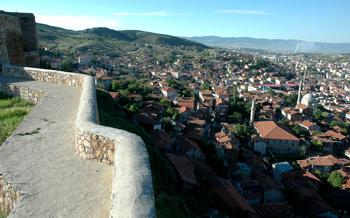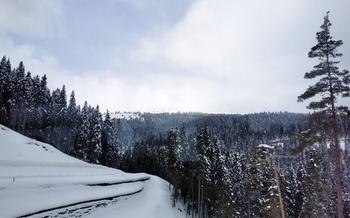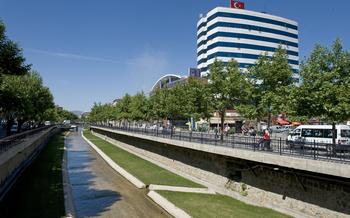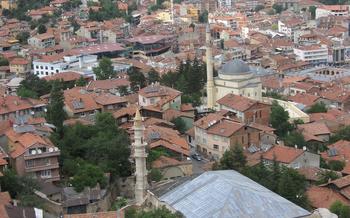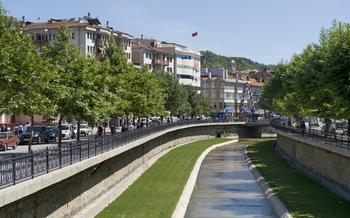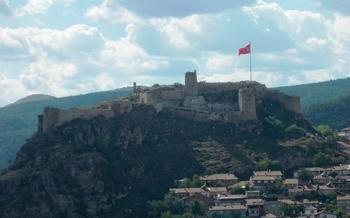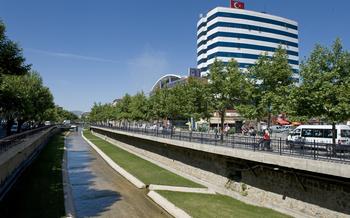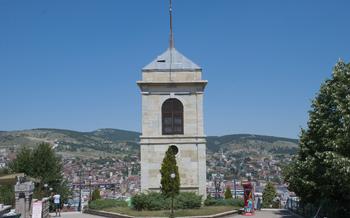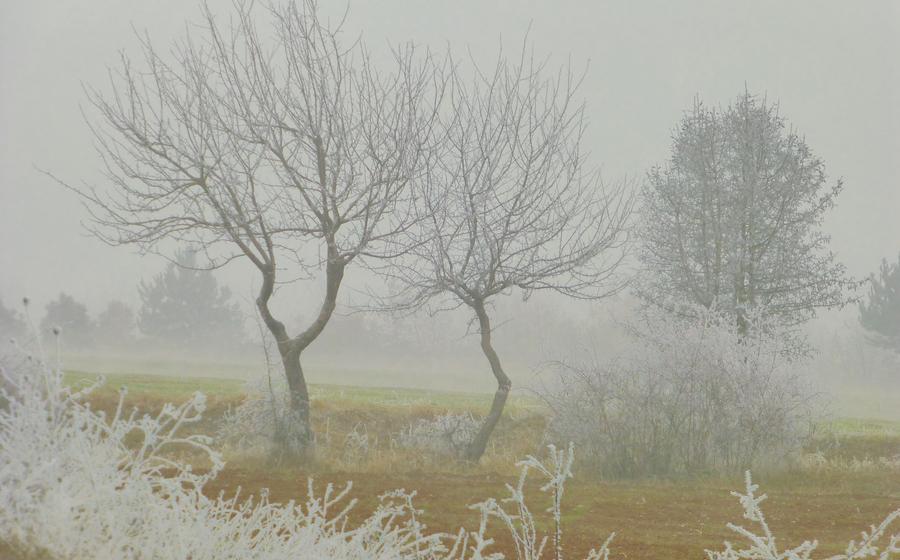
Tosya Historical Wooden Houses
- The Historical Significance of Tosya's Wooden Houses
- Exploring the Neighborhood
- Architectural Marvels
- A Journey Through Time
- Preservation Efforts
- A Stroll Down Memory Lane
- Local Crafts and Artisanship
- Culinary Delights
- Shopping Treasures
- Nightlife and Entertainment
- Festivals and Events
- Day Trips and Excursions
- Practical Tips for Visitors
- Insider Tip: Unveiling the Hidden Gem of the Tosya Neighborhood
The Historical Significance of Tosya's Wooden Houses
Tosya's wooden houses are a testament to the rich cultural heritage of Kastamonu, a city nestled in the heart of Turkey's Black Sea region. These beautifully preserved structures, dating back to the 19th century, offer a glimpse into the architectural traditions and lifestyles of a bygone era. Constructed using local materials and craftsmanship, they showcase a unique blend of traditional Turkish and Ottoman architectural styles.
The wooden houses are not just architectural marvels but also serve as a living museum, embodying the city's historical and cultural identity. They played a vital role in the development of Kastamonu, housing merchants, artisans, and prominent families who contributed to the city's economic and social fabric. Today, these houses stand as a reminder of Kastamonu's rich past, inviting visitors to embark on a journey through time and discover the stories they hold within their walls.
Exploring the Neighborhood
Nestled in the heart of Kastamonu, the Tosya neighborhood exudes an air of tranquility and charm. To reach this hidden gem, simply follow the winding streets that lead away from the city center. As you approach, the distinctive wooden houses emerge, their intricate carvings and colorful facades hinting at the rich history and cultural significance that lie within.
The neighborhood seamlessly blends with the surrounding community, offering a glimpse into the everyday lives of its residents. Engage with the locals, who are renowned for their warm hospitality, and immerse yourself in their traditions. Whether it's savoring a cup of Turkish coffee at a local café or browsing the vibrant markets, there are countless opportunities for authentic interactions and cultural exchanges.
Architectural Marvels
The wooden houses of Tosya stand out for their distinctive architectural features, which blend traditional Turkish and Ottoman influences. One of the most striking elements is the bay windows, which protrude from the upper floors and offer panoramic views of the neighborhood and the surrounding landscapes. These bay windows are often adorned with intricate carvings and latticework, showcasing the skill and artistry of the local craftsmen.
The facades of the houses are painted in vibrant colors, creating a cheerful and inviting atmosphere. The colors are carefully chosen to complement the natural surroundings and to reflect the changing seasons. The use of wood as the primary building material lends a warm and rustic charm to the neighborhood, making it a popular spot for photographers and art enthusiasts.
The construction techniques employed in the wooden houses are a testament to the ingenuity and expertise of the local builders. The houses are built on stone foundations and feature a sturdy wooden framework. The walls are made of thick wooden planks, which provide insulation against the harsh weather conditions of the region. The roofs are typically made of terracotta tiles or wooden shingles, adding to the overall charm and authenticity of the neighborhood.
A Journey Through Time
The wooden houses of Tosya stand as silent witnesses to the rich history of Kastamonu. Each house holds within its walls a treasure trove of stories, waiting to be uncovered by curious travelers. One such tale speaks of a young woman named Ayşe, who lived in one of these houses during the early 1900s. Ayşe was known for her rebellious spirit and her love of adventure. One day, she defied her family's wishes and ran away with a traveling musician, leaving behind the confines of her traditional life. Years later, she returned to Tosya, her heart filled with both regret and longing. The wooden house where she grew up remained unchanged, a reminder of the choices she had made and the life she had left behind.
Over the centuries, the wooden houses of Tosya have borne witness to countless other stories of love, loss, joy, and sorrow. They have seen empires rise and fall, wars waged and won, and generations come and go. The creaking floorboards and faded paint hold the memories of countless lives, each one contributing to the rich tapestry of Kastamonu's history.
Today, visitors to Tosya can still sense the echoes of the past as they wander through the neighborhood's narrow streets. The wooden houses, with their intricate carvings and colorful facades, seem to whisper secrets to those who listen closely. In the evening, as the sun sets and the air turns cool, the neighborhood takes on a magical aura, as if the spirits of the past are returning to reclaim their homes.
Preservation Efforts
Preserving the historical legacy of Tosya's wooden houses is of paramount importance. Recognizing their cultural significance, several initiatives and projects have been undertaken to protect and restore these architectural treasures. Local authorities, in collaboration with heritage organizations, have implemented restoration programs aimed at maintaining the structural integrity of the houses while respecting their original designs. These efforts involve meticulous restoration techniques, using traditional materials and craftsmanship to ensure authenticity.
However, preserving the wooden houses comes with its set of challenges. The passage of time, exposure to harsh weather conditions, and the natural aging process pose significant threats to these structures. Balancing the need for preservation with the demands of modern living can be a delicate task. Integrating contemporary amenities and ensuring accessibility while preserving the historical character of the houses requires careful planning and expertise.
Despite these challenges, the preservation efforts have yielded remarkable results. Many of the wooden houses have been restored to their former glory, showcasing their intricate carvings, vibrant facades, and unique architectural features. These restored houses now serve as vibrant cultural centers, museums, cafes, and guesthouses, allowing visitors to experience the neighborhood's rich history and charm while contributing to its preservation.
A Stroll Down Memory Lane
Strolling through the Tosya neighborhood is akin to embarking on a journey through time, where history and tradition intertwine at every corner. Admire the intricate carvings adorning the wooden facades, each telling a unique story. Discover hidden courtyards, reminiscent of a bygone era, where the gentle sound of a fountain echoes through the air.
Take a moment to pause at the Tosya Ethnography Museum, a treasure trove of local history and culture. Immerse yourself in the stories of the people who once called these wooden houses home, and gain a deeper appreciation for the neighborhood's rich heritage.
Capture the essence of your visit through photography, ensuring that the vibrant colors and architectural details of the wooden houses are forever etched in your memories. Embrace the opportunity to engage with the local community, sharing stories and experiences that will enrich your understanding of this special place.
Local Crafts and Artisanship
The Tosya neighborhood is renowned for its vibrant tradition of crafts and artisanship. Visitors can immerse themselves in the creative spirit of the area by visiting workshops and studios where skilled artisans showcase their mastery. From intricate woodworking and metalworking to delicate embroidery and pottery, the neighborhood offers a diverse range of traditional crafts.
One of the highlights is the art of marquetry, where artisans create stunning decorative pieces by fitting together small pieces of wood or other materials to form intricate patterns. Visitors can witness the painstaking process of creating these intricate artworks and even try their hand at marquetry under the guidance of experienced craftsmen.
Another popular craft is carpet weaving, where artisans use traditional techniques to create colorful and intricate carpets that adorn the homes of locals and visitors alike. Visitors can learn about the different types of carpets, the symbolism behind their patterns, and even purchase unique handwoven pieces as souvenirs of their visit.
For those interested in pottery, the neighborhood is home to several workshops where artisans create beautiful ceramic pieces using traditional methods. Visitors can watch the potters at work, learn about the different types of clay and glazes used, and even try their hand at throwing a pot on the potter's wheel.
Exploring the local crafts and artisanship in the Tosya neighborhood is an enriching experience that allows visitors to connect with the cultural heritage of the region and take home unique souvenirs that reflect the creativity and skill of local artisans.
Culinary Delights
Kastamonu and the Tosya region are renowned for their distinctive cuisine, which blends traditional Turkish flavors with local influences. Visitors to the Tosya neighborhood can indulge in a variety of culinary delights, from hearty kebabs to mouthwatering pastries.
-
Traditional Dishes:
-
Kastamonu's signature dish is "mantı," delicate dumplings filled with minced meat and topped with yogurt, garlic sauce, and paprika butter.
- "Kuru fasulye," a hearty stew of white beans, is another local favorite, often served with rice or pilaf.
-
For a taste of regional cuisine, try "Tosya kebabı," grilled lamb skewers marinated in a flavorful blend of spices.
-
Local Delicacies:
-
Sweet lovers mustn't miss "Kastamonu ekmeği," a flaky pastry filled with a sweet walnut and molasses filling.
- "Kuyu kebabı," a unique dish cooked in clay pots buried underground, offers a tender and succulent lamb experience.
-
"Çöven," a refreshing drink made from fermented wheat, is a local specialty worth trying.
-
Vegetarian Options:
-
Vegetarians can enjoy "gözleme," a savory flatbread filled with spinach, cheese, or potatoes.
- "Mercimek çorbası," a hearty lentil soup, is another popular choice, often served with crusty bread.
- "Pırasa böreği," a filo pastry filled with leeks and herbs, offers a delicious and nutritious alternative.
Shopping Treasures
The Tosya neighborhood is a treasure trove for shopping enthusiasts, offering a unique blend of traditional Turkish crafts, contemporary art, and local souvenirs.
Antique shops line the narrow streets, showcasing a curated collection of vintage furniture, jewelry, and decorative items. Art galleries display the works of local and international artists, from paintings and sculptures to ceramics and textiles.
Stroll through the neighborhood's boutiques to find handmade crafts, such as intricate lacework, hand-woven rugs, and colorful pottery. These items make for meaningful souvenirs to cherish or thoughtful gifts for loved ones back home.
For those seeking traditional Turkish textiles, the neighborhood offers a variety of shops selling hand-woven kilims, intricate embroideries, and vibrant ikat fabrics. These textiles can be used to create unique home décor items or as beautiful additions to your wardrobe.
Remember to embrace the art of bargaining when shopping in the neighborhood. While prices are generally reasonable, engaging in friendly negotiations is a cultural norm and can often lead to great deals.
Whether you're looking for a one-of-a-kind piece of art, a unique souvenir, or a traditional Turkish textile, the Tosya neighborhood has something to offer every shopper.
Nightlife and Entertainment
The Tosya neighborhood comes alive at night with a vibrant nightlife scene that caters to a diverse crowd. From atmospheric bars and pubs to traditional Turkish music venues, there's something for everyone to enjoy.
For a lively night out, head to one of the many bars or pubs in the area. These establishments offer a relaxed atmosphere, friendly locals, and a wide selection of drinks, including local beers and wines. Some popular spots include the Tosya Bar, the Wooden House Pub, and the Kastamonu Meyhane.
If you're looking for a more traditional experience, check out one of the neighborhood's Turkish music venues. These venues showcase live performances of traditional Turkish music and dance, providing a glimpse into the rich cultural heritage of the region. The Tosya Music Hall and the Kastamonu Folk Music Center are two popular options.
No matter your preference, you're sure to find something to your liking in the Tosya neighborhood's nightlife scene. So come out, explore, and enjoy a night to remember in this charming and historic part of Kastamonu.
Festivals and Events
The Tosya neighborhood comes alive during annual festivals and events that showcase the rich culture and traditions of the region. The most notable event is the Tosya Wooden Houses Festival, held every year in the summer. This vibrant festival celebrates the unique architecture and heritage of the neighborhood, with a variety of activities and performances. Visitors can enjoy traditional Turkish music and dance performances, sample local delicacies, and participate in workshops and demonstrations showcasing traditional crafts and handicrafts.
Another popular event is the Kastamonu International Culture and Art Festival, which takes place annually in the city center. This festival brings together artists and performers from around the world, offering a diverse range of cultural experiences. Visitors can enjoy live music concerts, art exhibitions, theater performances, and much more.
For those interested in history and culture, the Kastamonu History Festival is a must-attend event. This festival delves into the rich history of the city and the surrounding region, with lectures, exhibitions, and guided tours to historical sites.
Planning a trip around these festivals is a great way to immerse yourself in the local culture and traditions of Kastamonu. Be sure to check the event calendar in advance to plan your visit accordingly and make the most of the festivities.
Day Trips and Excursions
The Tosya neighborhood in Kastamonu serves as an excellent starting point for exploring the region's rich history, natural wonders, and cultural heritage. Within easy reach of the city, you'll find a treasure trove of attractions that will captivate your senses and leave you with lasting memories.
Just a short drive away, you can visit the stunning Ilıca Waterfall, where the cascading waters create a mesmerizing spectacle. For a glimpse into the region's past, head to the historic city of Safranbolu, a UNESCO World Heritage Site renowned for its well-preserved Ottoman architecture and vibrant cultural scene.
Nature enthusiasts will delight in exploring the Küre Mountains National Park, home to diverse flora and fauna, including the endangered Anatolian leopard. Take a leisurely hike through the park's scenic trails, and keep your eyes peeled for wildlife encounters.
For a unique cultural experience, consider visiting the nearby village of Araç, famous for its traditional Turkish handicrafts. Watch skilled artisans create intricate carpets, pottery, and jewelry using techniques passed down through generations.
These are just a few of the many day trips and excursions you can take from the Tosya neighborhood. With its convenient location and wealth of nearby attractions, Kastamonu offers endless possibilities for adventure and exploration.
Practical Tips for Visitors
Before embarking on your journey to the Tosya neighborhood, it's essential to arm yourself with practical travel information to ensure a smooth and enjoyable experience.
Visa Requirements: Most nationalities require a visa to enter Turkey. Please check the Turkish embassy or consulate in your country for specific visa requirements and application procedures.
Currency Exchange: The official currency of Turkey is the Turkish Lira (TRY). You can exchange your currency at banks, exchange bureaus, and hotels. Credit cards are widely accepted in most establishments.
Local Customs: As a visitor to Turkey, it's important to be respectful of local customs and traditions. Dress modestly, especially when visiting religious sites. Greetings typically involve a handshake or a slight bow.
Best Time to Visit: The best time to visit Kastamonu and the Tosya neighborhood is during the spring (April-May) or autumn (September-October) when the weather is pleasant and mild. Summer months can be hot and crowded, while winters can be cold and snowy.
Safety Tips: Kastamonu is generally a safe city, but it's always advisable to take precautions. Be aware of your surroundings, avoid walking alone at night, and keep your valuables secure.
By following these practical tips, you can ensure a hassle-free and enriching experience while exploring the historical wooden houses of Tosya and the vibrant city of Kastamonu.
Insider Tip: Unveiling the Hidden Gem of the Tosya Neighborhood
As you stroll through the charming lanes of the Tosya neighborhood, keep an eye out for a hidden gem tucked away amidst the wooden houses: the Tosya Ethnography Museum. This unassuming museum houses a captivating collection of artifacts, photographs, and documents that narrate the rich history and cultural heritage of the region.
Immerse yourself in the captivating stories of the neighborhood's past inhabitants as you explore exhibits showcasing traditional costumes, household items, and tools. Discover the unique customs, beliefs, and traditions that have shaped the identity of the Tosya community over centuries.
The museum's knowledgeable staff is always eager to share their insights and anecdotes, providing visitors with a deeper understanding of the neighborhood's significance. Don't miss the opportunity to engage in thought-provoking conversations and gain a local's perspective on the Tosya neighborhood's heritage.
Whether you're a history buff, a culture enthusiast, or simply someone who appreciates hidden gems, the Tosya Ethnography Museum is a must-visit destination. It offers a glimpse into the soul of the neighborhood and leaves visitors with a lasting appreciation for the region's rich tapestry of traditions.

